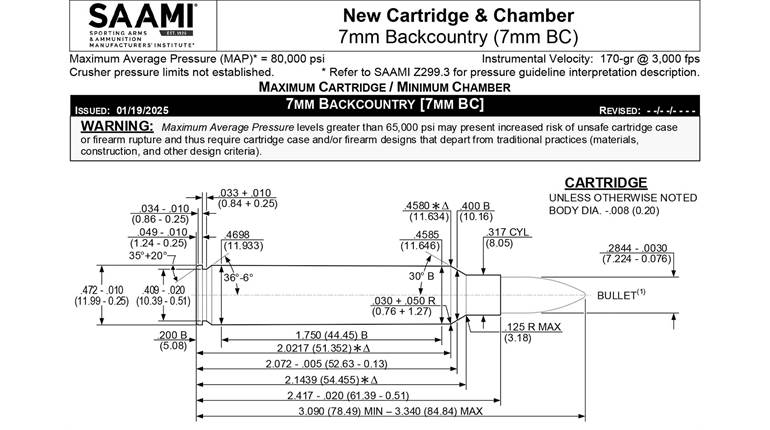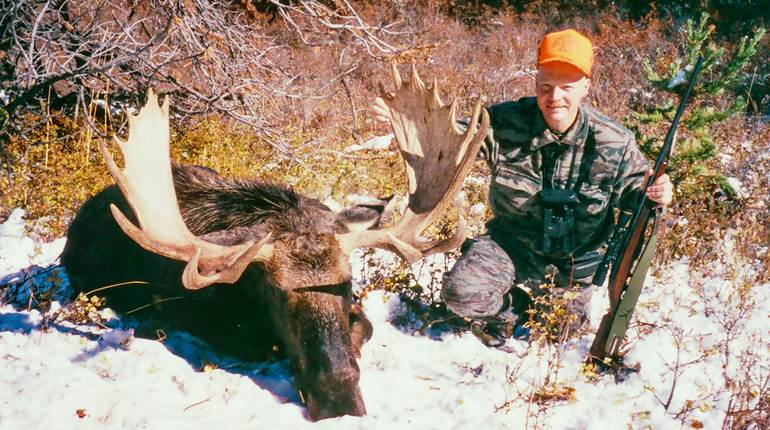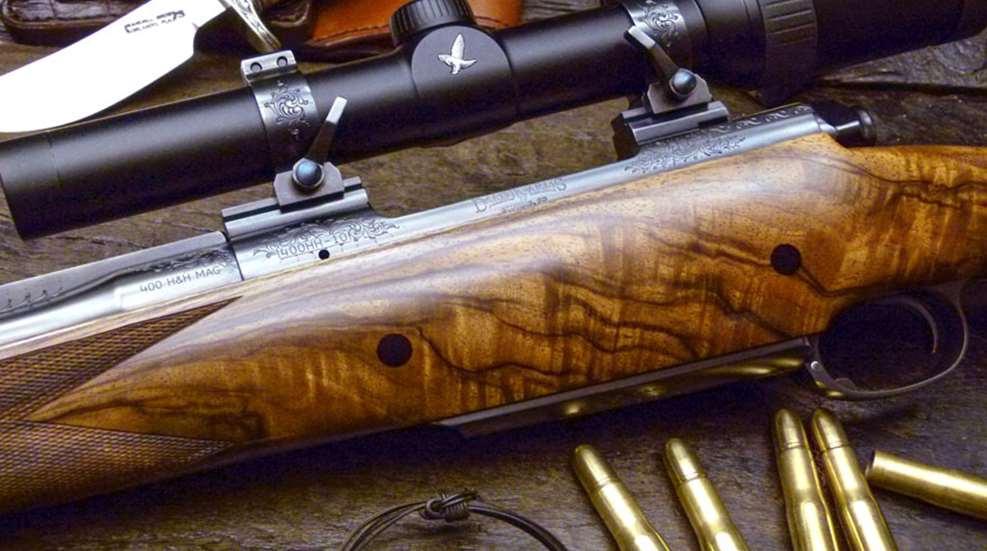
This upgraded Dakota Model 76 in .400 H&H Mag. is stocked in beautiful walnut and embellished with scroll engraving.
Do we really need another big-bore cartridge? That’s what I asked myself when I first heard about the .400 Holland & Holland Magnum a dozen years ago. But maybe we do, if it’s the right one. There are two reasons for this. First: Although it’s a fact that, here in North America, cartridge sales drop like a rock when you go above .30 caliber, interest in large-caliber dangerous-game cartridges has long exceeded their practical necessity. For many years the only common choice available was the .458 Win. Mag. Introduced in 1956, it far outsold expectations, and it’s almost certain that many rifles so chambered never made it to Africa (as is probably the case with all of our big-bore cartridges). Clint Eastwood used a .458 as Inspector “Dirty Harry” Callahan, and when I was a kid we called the .458 the “California Can Roller.” Second, and far more importantly, if you actually need a dangerous-game cartridge to stop a Big Nasty, then you need it badly—and it must be a good one.
Lots Of Choices
From the 1950s through the 1980s our choices in factory dangerous-game cartridges were limited to the .375 H&H Mag., .458 Win. Mag. and Weatherby’s numbers in the same bullet diameters. Even during that period, however, handloaders and custom suppliers were keeping the old British Nitro Express cartridges alive, and wildcatters were developing in-between options in, say, .40 to .42 caliber. Some of the better known in this latter group were the .411 KDF, .416 Hoffman and .425 Express.
Things changed fast in the late 1980s. In quick succession Remington brought out its .416 Rem. Mag., Federal resurrected the .416 Rigby and Weatherby countered with its fast .416 Wby. Mag. Today all of these cartridges are available in production rifles with over-the-counter ammunition, along with .458 Lott, .416 Ruger and the great old .404 Jeffery—not to mention a bunch of the older Nitro Express cartridges now loaded by Hornady and Norma, among others. We already have lots of proven choices, so it’s a valid question: Do we really need another?
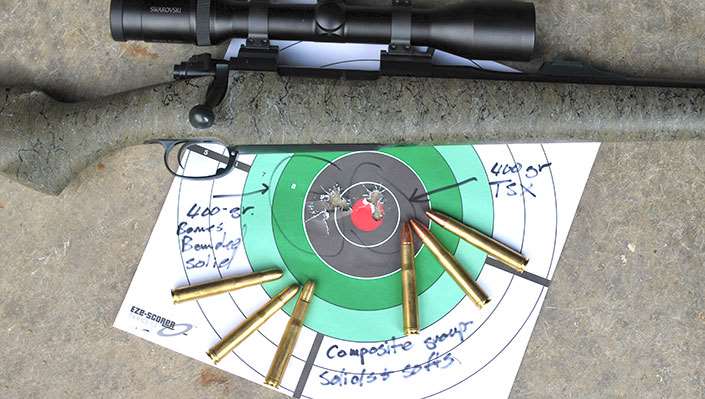
The .400 H&H Magnum
There wasn’t a lot of fanfare when the British firm of Holland & Holland brought out the .400 H&H Mag. in 2003. Perhaps there should have been; it was Holland & Holland’s first new cartridge in many a year. The problem is that H&H is a custom firm, producing a small number of costly rifles, so the ripples were limited and barely made it across the pond.
The cartridge was developed by H&H’s Russell Wilkin, based on necking up the .375 H&H case to accept a 0.411" bullet. This is not an exceedingly common diameter, but it was used in the .411 KDF and other wildcats. The standard 400-gr. 0.411" bullet is available from Barnes and Woodleigh (softs and solids from both firms), and this is also the nominal diameter for the .405 Win., so Hornady’s 300-gr. InterLock bullets can be used as well. Hornady’s 0.410" bullets (for the .450/.400) are one-thousandth of an inch undersize, so they can also be used with perfect safety, but will be accurate in some barrels and perhaps not in others.
The interesting thing, to me, is that Wilkin’s case design is very retro, almost archaic. In 2003 “unbelted magnums” were hot, with Remington’s Ultra Mag family and Winchester’s Short Magnum family in heated competition. The current style was (and in most cases still is) not only unbelted, but also with minimal body taper and short necks to create as much propellant space as possible. Thus the .400 H&H seems to be a bit of a throwback, based on a belted case and having a lot of taper and a very long neck. Visually, it harks back to its daddy, the .375 H&H Mag. (1912) and its little brother, the .300 H&H Mag. (1925). Also, in body taper, sloping shoulder and long neck, it bears a strong resemblance to the .404 Jeffery (1909).
Reamers and dies are readily available, and there’s no shortage of .375 H&H Mag. brass, so in addition to genuine Holland & Holland rifles some number of custom .400 H&H Mag. rifles have been built in this country. The new development, however, is that Dakota Arms in Sturgis, S.D., has sort of adopted the .400 H&H Mag. and is pushing it hard. It was a synthetic-stocked Dakota Model 76 Professional Hunter with Dakota ammunition that I used for my range work.
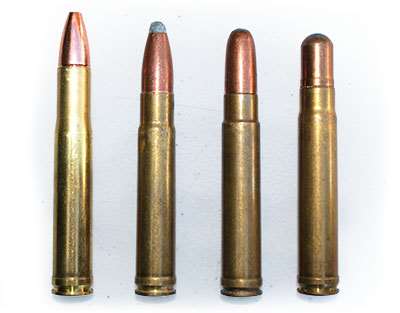
Built To Feed, Not For Speed
The .400 H&H Mag. is a departure for Dakota. As a custom and semi-custom firm, Dakota will chamber rifles to just about any cartridge you can think of, but in the 1990s the company was pushing its own line of Dakota Magnum cartridges. Based mostly on the .404 Jeffery case, they are fast, unbelted cartridges with sharp shoulders. These, together with Lazzeroni’s extensive line of proprietary cartridges, should be considered the immediate forerunners to both Remington’s RUMs and Winchester’s WSMs.
The .400 H&H Mag. is not the fastest in its class. It is a “full-length” cartridge with a 2.85" case, the same as its parent .375 H&H Mag., and requires the same action length. But the body taper and long neck reduce propellant capacity, so the .400 H&H develops a bit over 2300 f.p.s. with a 400-gr. bullet, yielding about 4,700 ft.-lbs. of muzzle energy. The gold standard for the “lower .40” crowd is generally considered the .416 Rigby, introduced in 1911. An unbelted giant of a cartridge, it produces 2400 f.p.s. with a 400-gr. bullet, yielding about 5,100 ft.-lbs. of energy. The .416 Rem. Mag. follows the same ballistic formula, but is based on the case of the .375 H&H Mag. Technically, the .416 Rem. Mag. is based on the 8 mm Rem. Mag. case, so it has quite a lot less body taper than the .400 H&H Mag.
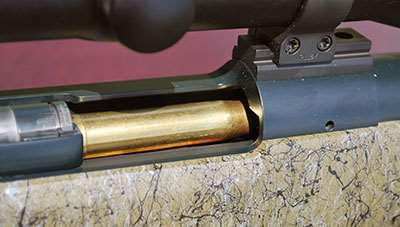
In these days of brave new magnums, many of us have forgotten how incredibly smooth-feeding the gently tapered cases like .300 and .375 H&H Mag. and the .404 Jeffery can be—they simply fall in and out of their chambers. This is not to say that the more modern case designs don’t feed well—but rarely with the slick smoothness of a tapered case. The long neck (0.636") obviously secures a death grip on the bullet, and it is unlikely to be pushed back even with repeated recoil.
What about headspacing on the belt as opposed to shoulder headspacing with an unbelted cartridge? Hmm. Well, shoulder headspacing is hardly new, going back to Peter Paul Mauser’s earliest smokeless cartridges and continuing with both the .404 Jeffery and .416 Rigby. Shoulder headspacing is more precise and, all things being equal, is probably conducive to better accuracy. Headspacing on the belt means that sloppy shoulder fit will still index properly and go bang, which is not altogether a terrible thing with a cartridge intended for dangerous game. As I’ve said, unbelted is “in” these days, but belted magnums have served us well since the .375 H&H Mag. was born back in 1912. From a user’s standpoint, the .400 H&H has a standard, belted-magnum rim diameter of 0.532". It will fit into any action that will house a .375 H&H Mag.
How Much Power Versus How Much Recoil?
Another obvious question then is, why not just use the .416 Rem. Mag.? It fits into the same size action with no modification, is clearly faster and more powerful, and is readily available in factory ammunition from multiple sources. I asked both Duke McCaa and his son, L.D. They are the principals at Gulf Breeze Firearms, Dakota’s top dealer, and they both love the .400 H&H. Their answer, phrased differently, was smoother feeding, less recoil, enough power to do the job and lower pressure. Also, from Dakota’s standpoint, the .400 H&H is an ideal cartridge to mate with a .300 H&H in a Model 76 “Traveler” switch-barrel takedown model.
A quick word on pressure, and then let’s address the power issue. As a modern cartridge with little body taper and a shorter neck (at 0.419", still a “full caliber” neck), the .416 Rem. Mag. is pretty much loaded to capacity. There is a long-standing rumor about its pressure issues in hot weather, but although I have tried to run this to ground I have never heard any first-hand reports. Certainly I have seen no pressure problems with the .416 Rem. Mag., including in the extreme heat of central Africa. But the rumor is out there. With their larger cases both the .404 Jeffery and .416 Rigby operate at considerably lower pressures, but as modern cartridges both the .416 Rem. Mag. and .400 H&H are specified to operate at full modern belted magnum pressures, maximum above 60,000 p.s.i. Actual working pressures are (hopefully) much less, and with its lower velocity, smaller propellant charge and tapered case (less abrupt burning curve), the .400 H&H operates at somewhat less pressure than the .416 Rem. Mag.—but I am not convinced this is a significant selling point.
As for power, once again, John Rigby set the bar: a 400-gr. bullet at 2400 f.p.s. for 5,100 ft.-lbs. The .400 H&H won’t quite get there. The Rigby formula is marvelously effective in the field, but let’s please understand that there’s no magic in those numbers. In days gone by the .450/.400 Nitro Express (there were actually two, a 3" and a 3¼") was probably the most popular of all large-caliber double-rifle cartridges, considered perfectly adequate for elephant and just ducky for buffalo and big cats. Bullet diameter varies vexingly in older .450/.400s. Hornady settled on 0.410" when it brought back the .450/.400-3", but actual barrel diameters can range from 0.408" to 0.412". That aside, Hornady’s current ballistics are: a 400-gr. bullet at 2050 f.p.s. for 3,732 ft.-lbs. of energy. This was considered adequate, and my experience with the .450/.400 on elephant and buffalo reinforces its effectiveness.
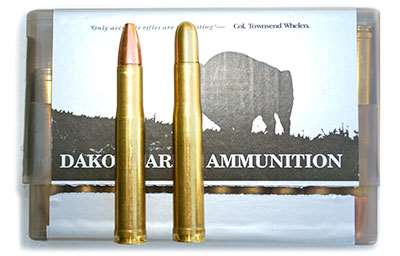
The .404 Jeffery was designed to duplicate .450/.400 ballistics in a bolt-action rifle. Original loads were: a 400-gr. bullet at 2125 f.p.s. for 4,020 ft.-lbs. of energy. The Jeffery case and the big Rigby case are larger than necessary because of the old Cordite stick powder. Modern loads are considerably faster, with a 400-gr. bullet at 2300 f.p.s., yielding right at 4,700 ft.-lbs., being fairly standard. These are the loads I’ve mostly used, and I really like the .404 Jeffery. It doesn’t require an extra-large action like the Rigby, doesn’t kick as much, and in the field I’ve never missed the extra velocity or energy. Again, if the .450/.400 is adequate (and it is), then any cartridge with a 400-gr. bullet traveling at 2300 f.p.s. is plenty adequate.
Thanks to modern propellants, the .416 Rem. Mag. duplicates .416 Rigby performance in a much smaller case, (the Rigby, however, will hold a lot more and can be pushed a lot faster.) Weatherby’s .378-.416-.460 family is essentially a .416 Rigby case with a belt added. The .416 Wby. Mag. produces 2700 f.p.s. with a 400-gr., bullet, yielding more than 6,400 ft.-lbs. of energy.
The formula used to derive kinetic energy (expressed in ft.-lbs.) uses the velocity squared. Recoil, Newton’s “equal and opposite” reaction, is also expressed in ft.-lbs. So, as velocity goes up both bullet energy and recoil energy increase exponentially. In an 11-lb. double rifle, the .450/.400 is a delight to shoot. A 400-gr. bullet traveling at 2300 f.p.s. produces a lot more recoil than a 400-gr. bullet at 2050 f.p.s.—but noticeably less than a 400-gr. bullet at 2400 f.p.s. Gun weight, of course, is always the easiest way to mitigate recoil, but a slightly lower-velocity load allows for a lighter rifle with the same recoil.
There is one more thing. Unlike velocity, projectile weight is not squared, but is obviously a factor, and it isn’t just the bullet weight, but what is called the ejecta—the bullet weight plus the propellant charge. Per the Hornady manual, in its extra-large case the .416 Rigby requires between 90.5 and 103.4 grs. of propellant (depending on which is used) to reach 2400 f.p.s. The .416 Rem. Mag. needs between 79.5 and 92.2 grs. of propellant to reach the same velocity, so if gun weight were identical it would have a bit less recoil. The .400 H&H needs between 10 and 20 fewer grains of propellant to reach 2300 f.p.s., so you have a recoil savings there as well.
Velocity & Accuracy
The ammunition I tested was Dakota’s proprietary load with 400-gr. Barnes TSX semi-spitzer and 400-gr. Barnes Banded Solid (a round-nose design). Though loaded by Dakota, they were headstamped “Barnes .400 H&H.” Cases can easily be made from .375 H&H brass, but it’s important to know properly headstamped cases exist, because some countries here and there insist that rifle rollmarks and cartridge headstamps match. Over my Oehler chronograph the TSX averaged 2321 f.p.s. for a five-shot string, while the solid managed 2315 f.p.s. Both were extremely consistent; extreme spread on the TSX was just 13 f.p.s.; and 30 f.p.s. for the solid. Standard deviations were a very low at 6 and 7, respectively.
The rifle I used was Dakota’s synthetic-stocked Professional Hunter, with a partially fluted barrel, good open sights, and a Swarovski Habicht 1-6X 42 mm scope in Talley mounts and rings. Its total weight was about 10 lbs. Over the years, I’ve found a lot of big-bore rifles mounted with low-power scopes to be exceptionally accurate if you can hold on to them, but this rifle was just plain spectacular. My first group was my absolute worst, 1.27". After that I better understood the trigger and knew the rifle wasn’t going to hurt me, and I bore down and did better.
Though straying away from the standard Rifleman protocol, my honest average of 10, three-shot groups was 0.705", under three-quarters of an inch. I didn’t fire as many solids as I did softs, but groups with the Barnes Banded Solids and TSXs were similar, excepting only that there was about 1.5" difference in point of impact between the two loads. My best group, after a total of nearly 60 rounds fired, was my last. I did this one a bit differently: I actually fired six shots, alternating between solids and softs. I wound up with two separate groups centered 1.3" apart, the TSX group measuring 0.636" and the Banded Solid measuring 0.390". Not bad for a big gun with a low-power scope.
How Did It Feel?
Well, it kicked! The only thing I know that’s worse than shooting a large-caliber rifle over a chronograph, is shooting groups off the bench. But I’ve experienced a whole lot worse. The rifle was actually very comfortable to shoot—again, dropping just 80 f.p.s. makes a noticeable difference, aided by adequate gun weight and a good, straight stock. Feeding was absolutely flawless, slick and smooth. Part of that, of course, is the excellent Dakota controlled-round-feed action, but I’ve known for a long time that there really is something to the tapered-case theory, and this rifle and cartridge reinforced that opinion.
My only regret is the timing was wrong to take it hunting. I’ve hunted with other Dakotas in other years—they’re great rifles. And I’ve taken enough big game with other cartridges throwing a 400-gr. bullet at that velocity to know that it’s plenty of gun.
With so many good choices available I’m not certain another cartridge in this power range is an absolute necessity, but the .400 H&H Mag. is definitely a good one, and I suppose there’s always room for one more. Offering smooth feeding and relatively mild recoil, the .400 H&H Mag. is well worth considering—especially if you’re looking for a big bore that’s a bit different.













